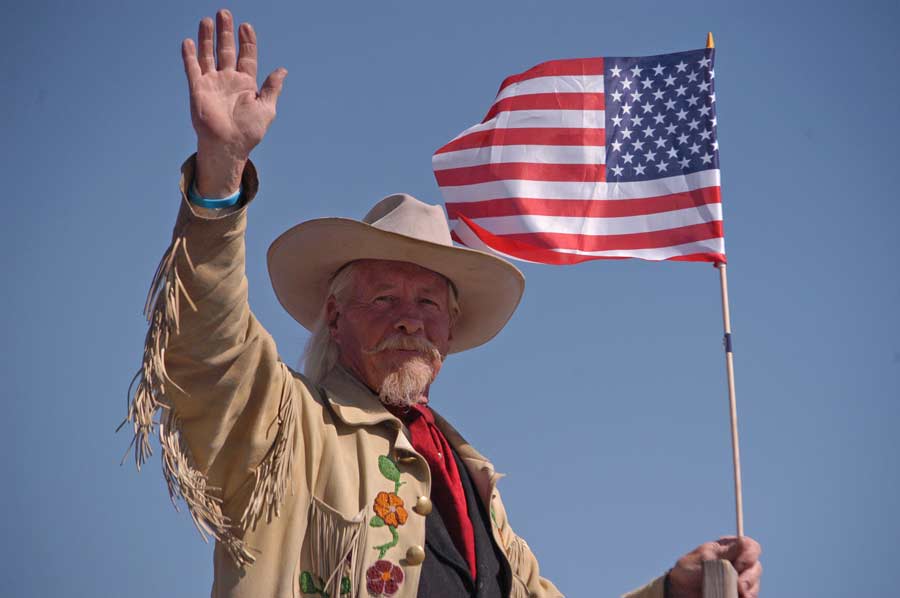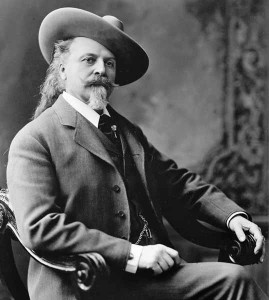
A Buffalo Bill Cody impersonator waves to the crowd in the town named for him during the 2012 Stampede Parade in Cody, Wyo. (Yellowstone Gate/Ruffin Prevost)
By Ruffin Prevost
CODY, WYO. — As part of its marketing campaign to attract visitors to Cody, Wyo. and the surrounding area, the Park County Travel Council is promoting William F. “Buffalo Bill” Cody as “the real Most Interesting Man in the World,” playing on the popularity of a fictitious hero form a series of beer commercials.
“Visit the town he created and land he loved,” says the Buffalo Bill travel ad running in publications read by likely visitors to Yellowstone National Park, including Yellowstone Gate.
After more than a century, the identity of the town and the legend of the man remain intertwined, and are repackaged and presented to visitors and residents as a mix of history and heritage, myth and marketing.
But a historian overseeing an exhaustive research project into Buffalo Bill’s papers says the real story of how the town came to be is more nuanced and complex than most people might think.
“History is complicated, and often there are not black-and-white answers to the questions of our shared past,” said Jeremy Johnston, managing editor of the Papers of William F. Cody at the Buffalo Bill Center of the West, formerly the Buffalo Bill Historical Center.
Johnston spoke Wednesday about the conflicting historical perspectives of Cody and his partner, George T. Beck, in the establishment of the town of Cody.
While the town is named after Cody, who is most widely credited as founding it, some historians argue that co-founder and partner Beck deserves as much or more credit, Johnston said.
Beck and a Sheridan, Wyo. banker, Horace Alger, had been looking into business ventures based on irrigation in Wyoming’s Bighorn Basin.
Carey Act
The federal Carey Act of 1894, sponsored by Wyoming Sen. Joseph Carey, allowed private developers to create irrigation systems in the semi-arid West and sell the water rights to settlers.

The history of William F. “Buffalo Bill” Cody is intertwined with that of the Yellowstone National Park gateway town that bears his name. (Photo courtesy of Buffalo Bill Center of the West)
Cody was probably recruited into a plan to do just that by Alger. Beck, Cody, Alger and others founded the Shoshone Land and Irrigation Co. in 1895, Johnston said, in a bid to cash in under the Carey Act, selling water rights in Wyoming’s Bighorn Basin.
Popular legend has Buffalo Bill creating the town of Cody as a tourist oasis to help share the wonder of Yellowstone with the world. But the truth is that Cody was founded at the site of a canyon that proved ideal for building a dam that was key to Buffalo Bill’s ambitious plan to irrigate 400,000 acres between the Shoshone River and the Bighorn Mountains.
Most of the early stories Cody told about the town and irrigation project’s initial days ignored the difficult work involved, and “instead focused on the scenic Bighorn Basin and its healthy environs in an effort to recruit settlers,” Johnston said.
Cody told a theatrical and compelling tale of the first time he saw the Bighorn Basin, Johnston said, after an eye infection had left him unable to see clearly.
“While visiting Deadwood (S.D.), a doctor prescribed a whiskey bath for his eyes. He didn’t follow through with that prescription for good reason,” Johnston said.
Cody then set out on a trip for the Bighorn Mountains with bandages over his eyes. Upon reaching the summit, he removed the bandages and looked out over the valley toward what would become the Cody town site. His vision began to return, and Cody later recalled that “no one looked upon a happier or more beautiful valley.”
Dueling hot springs
Buffalo Bill claimed it was water from DeMaris Hot Springs, at the original Cody town site, that healed his afflicted eyes. A later account in a Thermopolis, Wyo. newspaper credited the Big Spring in that town, Johnston said.
Eventually, the irrigation project had to be scaled back, and the town of Cody struggled at times to attract settlers, but it survived and continued to grow.
“Cody was one of the few success stories under the Carey Act,” Johnston said.
“Building a new community is tough. Wyoming is full of ghost towns,” he said.
While Cody and Beck had an adversarial business relationship—Cody doubted Beck’s competence and even sometimes questioned his honesty—the two men had complementary skills. Beck was able to mange the day-to-day details of the project, while Cody had money to invest and unprecedented global fame to promote their new settlement.
The town of Cody probably would have survived if Beck had teamed up with a less famous partner, Johnston said, but it would today be similar to other decidedly less famous Wyoming towns near irrigation projects, like Lovell or Wheatland.
Ultimately, it may be Cody’s fame and continuing status as a mythic Western figure that has meant the most to the town.
“The town probably would have made it, but I don’t think it would be the community we have now,” he said. “We certainly wouldn’t have the spirit of the West that we have today without Buffalo Bill Cody.”
Contact Ruffin Prevost at 307-213-9818 or ruffin@yellowstonegate.com.

I will take some issue with the fairy tale that Buffalo Bill first laid eyes on the Big Horn Basin when he removed the bandages and gazed downupon the basin from on high.
Many years ago I read a massive Buffalo Bill biography-semiautobiography. Colonel Cody or his scribe wrote in there of Cody’s first sortie into the Big Horn Basin . He had been hired by a professor during the infamous Dinosaur Bone Wars of the 1880’s to go into the Basin country and scout the formations. Cody was hired for his skill with Indians and of course his scouting skills, but he had never been to the territory in question.
I believe this occured in 1884 roughly . Stated in Cody’s own matter of fact account. So the town of Cody was possibly seeded by a desire for dinosaur fossils.
By the way , the opriginal name for the town was supposed to be Shoshone WY, but tnhe Post Office wouldn’t accept that because another town by that same name but spelled slightly differently already existed, ShoshonI WY south of the Wind River Canyon. The other name for the new town , also rejected, was the wholly uncreative ” Richland”. Beck & Co. finally agreed that the showman’s name would work best of all…Cody . It never was Buffalo Bill’s idea to use his name. He agreed to that afterwards.
Having noted that , “CODY ” is the most marketable four letter word in the West. Quite the brand.